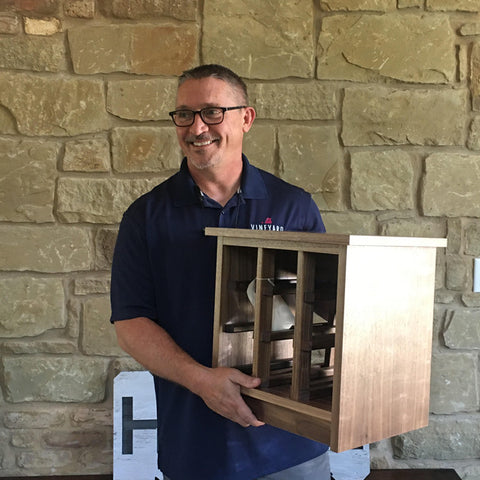
Building Your Own Wine Cellar? Check Out These 3 Wine Cellar Insulation Options
3 Great Wine Cellar Insulation Options
There are three types of wine cellar insulation you can use in your space. If you're building your own wine cellar, you need to know about all three, so you can choose the right one for keeping your collection secure. Custom cellars are very often the best place to store wine because they allow you to control all the variables for creating the ideal storage conditions. Insulation is one of those key variables.
If the insulation is done well from the beginning, everything else will fall into place. With the proper insulation, you'll be able to choose a wine cooling unit based on ideal conditions, meaning you won't have to size up to control space with lots of air leaks. You'll also extend the life of your unit and save on maintenance costs over time.

1. Fiberglass Batt Insulation: a Good Option
Experts in wine storage recommend that you always use a minimum of R-13 insulation, and it's possible to get this with fiberglass batts. If you choose fiberglass batts as your insulation method, don't forget that you'll need a 6-millimeter vapor barrier on the warm side of all the walls to protect against interstitial condensation. Take the time to install this carefully, as improperly installed vapor barriers can actually trap moisture in the walls.Some experts will wrap the entire inside of the walls, leaving plastic vapor sheeting loose in the stud cavity. With this method, the insulation batts can go between each stud. Another option is to roll in the batting between the stud spaces. When that's finished, the whole storage area is completely wrapped with vapor barrier sheeting. Don't forget that every single wall, and the ceiling and floor, must all be wrapped in plastic sheeting if you want a truly effective vapor barrier.
This is the cheapest way to insulate your wine cellar, but it's also the method that presents the most issues if the installation is done poorly. Even a small gap can reduce your wine cellar insulation efficiency by as much as 25%. If you choose this method, consider asking a professional builder for help to make sure everything is set up correctly. Also remember that fiberglass batting requires the right safety wear, as the resins can be hard on your skin, so makes sure you've got gloves and eye protection as well as long-sleeved pants and shirts.
2. Rigid Foam Board Insulation: a Better Option
Rigid foam board made from polystyrene is a common insulating material for wine cellars. This type of insulation will also require a plastic vapor barrier. When rigid foam board for your wine cellar insulation, you need two layers of panels, each layer an inch and a half thick. This will give you an R-19 insulation rating for your wine storage.These are easy to install, which is one reason they're such a popular choice for wine cellars. However, they do have the disadvantage of being difficult to get around any kind of wiring, piping, or conduits. If any of these have to get through your cellar wall, you will have to wrap the wires and pipes in rigid foam, or you'll need to cut holes in the rigid foam board to accommodate the wiring and then fill in the gaps with a spray foam insulation.
This is a very cost-efficient solution, and it provides a balance between the low cost but higher risk of fiberglass batt insulation and the more expensive polyurethane spray foam option. It's also easier to do correctly than fiberglass batt, though not as simple as polyurethane spray foam: especially if you have a lot of cracks, holes, and conduits that need to be filled in.
3. Spray Foam Insulation: the Best Option
For wine cellar insulation, nothing beats closed-cell spray foam. Just three inches of polyurethane spray foam will give you R-19 insulation. Even better, when you use spray foam, it skims over and creates its own vapor barrier. This means there's no need to install any plastic sheeting! It's important to choose closed-cell foam and not open-cell foam for this application. Closed-cell spray foam cures far more rigidly and will stop convection both through the and within the wall cavity.The beauty of polyurethane spray foam is that it expands. This means that once it's sprayed, it will move in to fill in every crap, hole, and crevice: even around wiring and piping. There are no gaps when you use polyurethane spray foam, and that means there's no chance for vapor to get through the material and cause any type of moisture issue. It's a lot easier to control the relative humidity of your wine cellar if you're using a closed-cell spray foam insulation method, too, meaning you'll need less moisture to maintain your RH. This provides support for your cooling system, so it will last a little longer and work a little less hard.
This is a particularly popular way of insulating custom wine storage areas, and the more piping and wiring you have running through your space, the more attractive this option becomes. You'll have no difficulty installing a great split system wine cellar cooling unit for a large space if you choose to use spray foam insulation.
All Your Wine Cellar Needs
For a complete overview of building a wine cellar check out our step-by-step how to guide, read now: How to Build a Wine Cellar (DIY Guide) .
At Wine Cellar HQ, we know wine and everything you need to store it well. Check out Wine Cellar HQ for all your cooling systems, wine coolers, and all the related stuff you need to create the perfect wine cellar!





Leave a comment